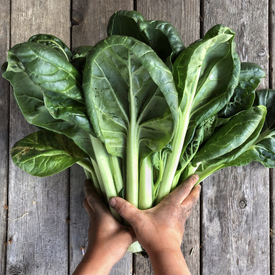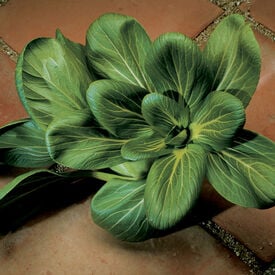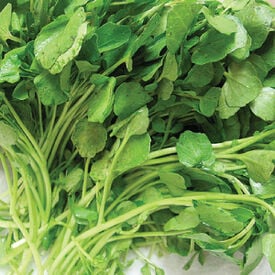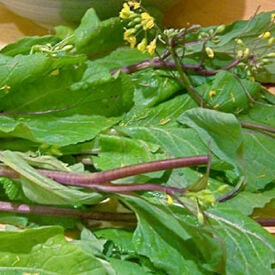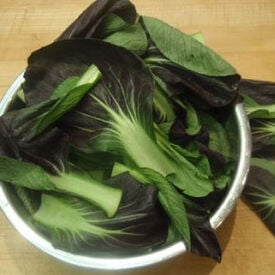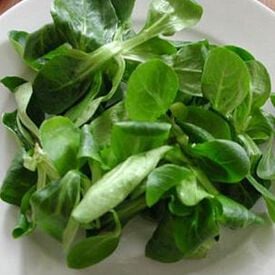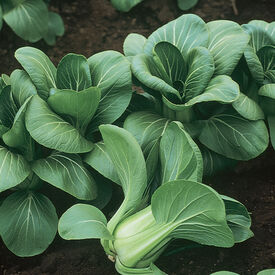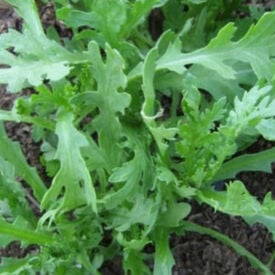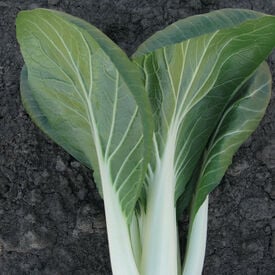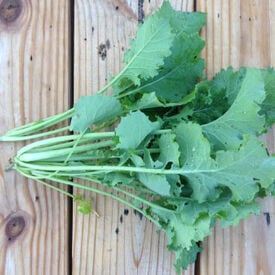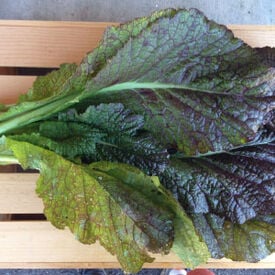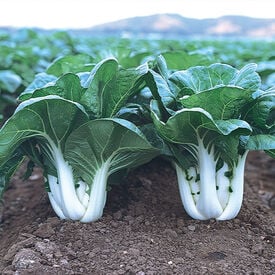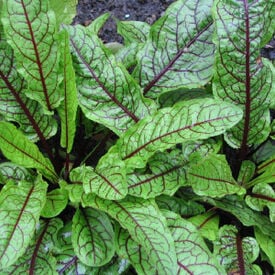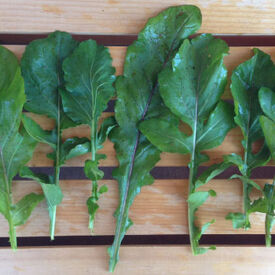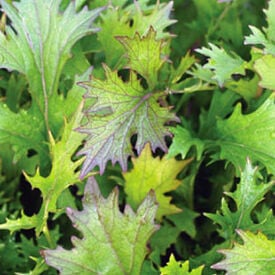Tatsoi is a flavorful and versatile Asian green that thrives in cooler weather, making it a popular choice for spring and fall plantings. Known for its glossy, dark green, spoon-shaped leaves, Tatsoi has a mild, mustard-like flavor with a slight sweetness, making it a great addition to salads, stir-fries, or as a garnish. Tatsoi seeds produce compact, rosette-shaped plants that grow quickly and are easy to harvest, often within 30 to 40 days. This hardy green is also appreciated for its high nutritional value, offering a rich source of vitamins A, C, and K, as well as calcium and iron. Its adaptability and fast-growing nature make Tatsoi a favorite among both commercial growers and home gardeners looking to add a nutrient-dense and visually appealing crop to their gardens.
Feng Qing Choi cabbage is a slow bolting Mei Qing Choi type with good plant size and dark leaf color. This variety has excellent holding ability and uniformity.
The Upland Cress is a highly nutritious aquatic herb. This cress is a slow to bolt green, but once it's established it will take off and have a long growing season! Upland's 6-8" rosettes of dark green, glossy, rounded leaves are very tasty and refreshing. Upland is very similar to watercress, but is much easier to grow!
The Hon Tsai Tai has deep purple tender stalks with a slight mustard flavor that is great in different salads or cooked into stir fries! Its green leaves have petite florets that are best harvested right before the bright yellow blossoms open. Hon Tsa Tai is best grown in mid to late summer.
The Curled Cress is a highly nutritious aquatic green. This cress has been cultivated for hundreds of years. This peppery and pungent cress has the same tangy flavor as watercress, as they are of the same botanical family. Curled cress is great for seed sprouting or microgreen growing!
Red Choi is a beautiful Pak Choi cabbage that has an excellent flavor cooked into meals! This variety is green with maroon veins that changes into a deep red color. The Red Choi has a compact growing habit.
Vit Mâche, also known as corn salad, lamb’s lettuce, or mâche, is a cool-season leafy green with a long history in Europe, where it was foraged in fields and vineyards before becoming a cultivated crop in the 17th century. This compact plant forms small rosettes of tender, spoon-shaped leaves that are deep green and naturally high in vitamins A and C. Its flavor is mild, slightly nutty, and gently sweet, making it a favorite for winter and early-spring salads. Mâche thrives in cool weather, germinating best in fall or early spring, and prefers rich, well-drained soil with consistent moisture. It’s cold-tolerant enough to survive light frosts, allowing gardeners to harvest the delicate rosettes over a long season with minimal care.
True Watercress is a delicious highly nutritious aquatic herb. This watercress has a wonderful fresh peppery-tasting flavor. Being semiaquatic, this cress is a creeping perennial whose leaves are popular in salads, sandwiches and as a garnish. True Watercress grow rapidly in in damp soil and can be grown in pots of soil placed in a tub of water if water is changed weekly.
Mei Qing Choi cabbage is a Shanghai pak choi type with good heat and cold tolerance and bolting resistance. In the U.S., this variety is harvested as baby pak choi. It is smaller than Joi Choi, weighing about a quarter of a pound. This pak choi has an excellent flavor and is extra tender.
Garland Serrate Leaf Greens is a delicious Japanese green that is an edible chrysanthemum. This popular Japanese green has serrated, dark green aromatic leaves that have an excellent flavor that becomes stronger with age. Garland Serrate is easy to grow and produces high yields with side shoots.
This pak choi's tender leaves and crisp sweet stalks are a tasty addition to recipes or eaten raw. Swap stalks for celery sticks, add to soups and stews, or grill on the barbecue. Plant every couple of weeks for successive harvests in spring and fall; Bopak retains it’s nice flavor even in warmer weather.
The Brilliant Rainbow Quinoa blends beautifully into meals or salads. Just like its name, this quinoa contains a spectrum of many different colored heads - red, orange, gold, white, and green. The Brilliant Rainbow Quinoa's leaves have a salty spinach-like flavor. Harvest for greens when 6-8" tall or let grow for beautiful tall blooms that can be harvested for grain. This Quinoa's grain has a nutty flavor that goes well with any dish!
The Dwarf Siberian Kale leaves are perfect as a garnish and in hearty winter dishes. This frilly green and purple kale dances in the crisp early morning cold and thrive. Why? Because its roots are from Russia!
The Red Giant is a large mustard with an excellent, pungent flavor. This variety is a large purple-red leaf type. The Red Giant is great used as an ornamental or salad garnish. This variety's flavor has a slight hint of wasabi and grey poupon.
The Joi Choi Bok Choy has very tender dark green leaves with crisp white stalks. This variety is slow bolting with high yields. Joi Choi Bok Choy is perfect for growing in fall and winter, as it is cold tolerant.
The Red Veined Sorrel is a delicate green with an excellent flavor! This Red Veined Sorrel is a fast growing green that adds a delicious flavor and texture to salads. This green's leaves are best young with a sharp tart flavor that is unique to this plant. The central vein is a dark maroon that webs out throughout the leaf. This variety has very showy leaves that is great for salads, soups, stews and more.
Roquette Arugula seeds produce a fast-growing, cool-season leafy green prized for its peppery, nutty flavor and tender, deeply lobed leaves. Also known as salad rocket, this Mediterranean native has been cultivated since ancient Roman times for both its culinary and medicinal qualities. Roquette arugula thrives in full sun to partial shade and prefers well-drained, fertile soil, reaching harvest size in as little as 30–40 days. Ideal for salads, sandwiches, or as a garnish, its bold flavor intensifies as the plant matures. Regular harvesting encourages new growth, making it a favorite for continuous garden production throughout spring and fall.
The Mizuna Purple Mustard produces bright purple tinged and sharply serrated green leaves. This is a tasty variety that is fast maturing and slow bolting.
